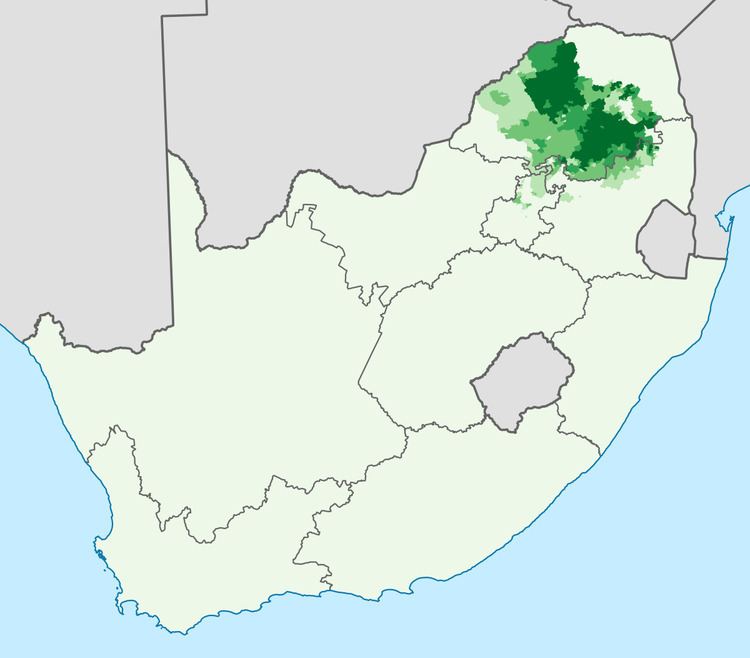Native to South Africa | ||
 | ||
Region Gauteng, Limpopo, Mpumalanga Native speakers 4.7 million (2011 census)
9.1 million L2 speakers (2002) Language family Niger–Congo
Atlantic–Congo
Benue–Congo
Southern Bantoid
Bantu
Southern Bantu
Sotho–Tswana
Sotho
Northern sotho Dialects Pedi (Masemola, Tau, Kone)
Lobedu (Kgaga)
Gananwa (Tlokwa)
Kopa (Ndebele-Sotho)
Birwa
Tswapong
? Phalaborwa
? Kutswe (East Sotho)
? Pai (East Sotho)
? Pulana (East Sotho) Writing system Latin (Sotho alphabet)
Sotho Braille | ||
Northern Sotho (Sesotho sa Leboa, also known by the name of its standardised dialect Sepedi or Pedi) is a Bantu language spoken primarily in South Africa, where it is one of the 11 official languages. According to the 2011 census it was the first language of 4,618,576 people in South Africa, principally in the provinces of Limpopo, Gauteng and Mpumalanga.
Contents
- Classification
- Confusion of nomenclature with Sepedi
- Other varieties of Northern Sotho
- Vocabulary
- References
Urban varieties of Northern Sotho, such as Pretoria Sotho (actually a derivative of Tswana), have acquired clicks in an ongoing process of such sounds spreading from Nguni languages.
Classification
Northern Sotho is one of the Sotho languages of the Bantu family. Northern Sotho is thus most closely related to Sesotho (Southern Sotho), Setswana, sheKgalagari and siLozi. It has several distinct varieties.
Lobedu (also Khilovedu or Selobedu) exists only in an unwritten form, and the standard Northern Sotho language and orthography is usually used for teaching and writing by this language community. The monarch associated with this language community is Queen Modjadji (also known as the Rain Queen). Lobedu is spoken mainly in the area of Modjadjiskloof in the Limpopo Province. Its speakers are known as the Balobedu.
Sepulana (also sePulane) also exists in unwritten form and forms part of the standard Northern Sotho. Sepulana is spoken in Bushbuckridge area by the Mapulana people.
Confusion of nomenclature with Sepedi
Northern Sotho has often been equated with its major component Sepedi, and continued to be known as Pedi or Sepedi for some years after the new South African constitution appeared. However, the Pan South African Language Board and the Northern Sotho National Lexicography Unit now specifically prefer and endorse the names Northern Sotho or Sesotho sa Leboa.
The original confusion arose from the fact that the (now official) Northern Sotho written language was based largely on Sepedi (for which missionaries first developed the orthography), but has subsequently provided a common writing system for 20 or more varieties of the Sotho-Tswana languages spoken in the former Transvaal (including dialects of Sepedi). The name "Sepedi" thus refers specifically to the language of the Pedi people, while "Northern Sotho" refers to the official language of that name and to all the speech varieties it has been taken to cover. (It should be noted that the ethnic name "Pedi" also refers to a ruling group that established its dominance over other communities in the 18th century and to the culture and lifestyle of that group and of those over whom it ruled.)
Other varieties of Northern Sotho
Apart from Sepedi itself, the other languages or dialects covered by the term "Northern Sotho" appear to be a diverse grouping of communal speech-forms within the Sotho-Tswana group. They are apparently united by the fact that they are classifiable neither as Southern Sotho nor as Tswana.
Very little published information is available on these other dialects of Northern Sotho, but these have been reported: kheLobedu (khiLobedu or seLobedu), seTlokwa, seBirwa, sePulana, seKhutswe, seTswapo and also SePai (transitional between Sotho-Tswana and Zulu/Swati), Sebididi( combination of Sotho-Tswana) is spoken primarily in the isolated villages north of the coal mining town Lephalale( formerly ellisrus). The morphological and possible lexical variation among these dialects has led to the above assertion that 'Northern Sotho' is no more than a holding category for otherwise unclassified Sotho-Tswana varieties spoken in northeastern South Africa. Maho (2002) leaves SePhalaborwa and the "East Sotho" varieties of SeKutswe, SePai, and SePulana unclassified within Sotho–Tswana. Their precise classification would appear to be a matter for further research.
Vocabulary
Some examples of Northern Sotho words and phrases:
slang
jargon
